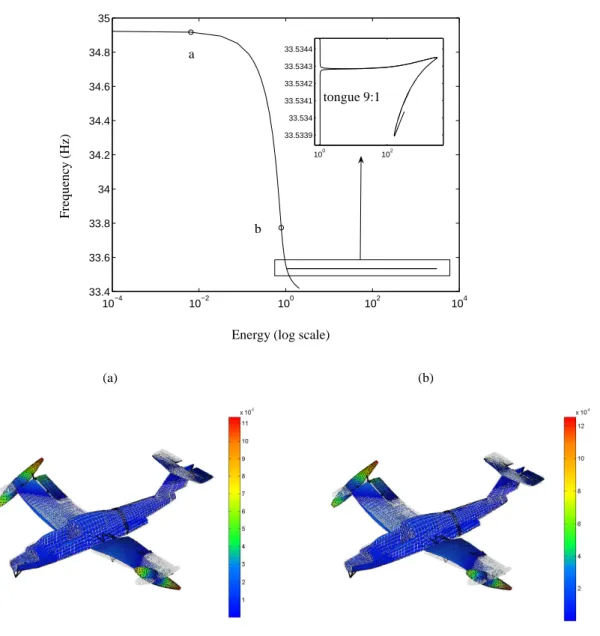ENOC 2011, 24-29 July 2011, Rome, Italy
Computation of nonlinear normal modes of large structures:
application to a full-scale aircraft
M. Peeters
∗, L. Renson
∗, G. Kerschen
∗, J.-C. Golinval
∗, C. St´ephan
∗∗, P. Lubrina
∗∗ ∗Aerospace and Mechanical Engineering Department, University of Li`ege, Li`ege, Belgium
∗∗Office National d’Etudes et de Recherches A´erospatiales (ONERA), DADS-ADSE, Chˆatillon,
France
Summary. The objective of this paper is to demonstrate that the numerical computation of the nonlinear normal modes (NNMs) of complex real-world structures is now within reach. The application considered in this study is the airframe of the Morane-Saulnier Paris aircraft, whose ground vibration tests exhibited some nonlinear structural behaviors. The NNMs are computed using a numerical algorithm combining shooting and pseudo-arclength continuation.
Introduction
Nonlinear normal modes (NNMs) offer a solid theoretical and mathematical tool for interpreting a wide class of nonlinear dynamical phenomena, yet they have a clear and simple conceptual relation to the LNMs [1, 2, 3]. However, most structural engineers still view NNMs as a concept that is foreign to them, and they do not yet consider NNMs as a useful concept for structural dynamics. One reason supporting this statement is that most existing constructive techniques for computing NNMs are based on asymptotic approaches and rely on fairly involved mathematical developments.
In this paper, we support that numerical algorithms pave the way for an effective and practical computation of NNMs. The proposed algorithm, implemented in MATLAB, relies on two main techniques, namely a shooting procedure and a method for the continuation of NNM motions. We show that the numerical computation of the NNMs of complex real-world structures, such as the finite element model of the full-scale aircraft studied herein, is then within reach.
Nonlinear normal modes
A detailed description of NNMs and of their fundamental properties (e.g., frequency-energy dependence, bifurcations and stability) are given in [3]. In the present study, an extension of Rosenberg’s definition is considered. An NNM motion is defined as a (non-necessarily synchronous) periodic motion of the conservative nonlinear mechanical system. The general equations of motion are
M ¨x(t) + K x(t) + fnl{x(t)} = 0 (1)
whereM is the mass matrix; K is the stiffness matrix; fnlis the nonlinear restoring force vector, including stiffness terms
only.
Algorithm for nonlinear normal mode computation
The numerical method for NNM computation is based on the continuation of periodic solutions. To this end, the proposed algorithm is a combination of shooting and pseudo-arclength continuation methods. It has been implemented in the MATLAB environment. A detailed description of the algorithm is given in [4].
The shooting method consists in finding, in an iterative way, the initial conditions and the period inducing an isolated periodic motion (i.e., an NNM motion) of the conservative system. To this end, the method relies on direct numerical time integration and on the Newton-Raphson procedure. A continuation method is combined with the shooting technique to determine successive NNM motions at different energy levels. The so-called pseudo-arclength continuation method is used herein.
Full-scale aircraft
The numerical computation of the NNMs of a complex real-world structure is addressed. This structure is the airframe of the Morane-Saulnier Paris aircraft. A specimen of this plane is present in ONERA’s laboratory, and ground vibration tests exhibited softening nonlinear behavior in the connection between the wings and external fuel tanks located at the wing tip.
Finite element model of the Morane-Saulnier Paris aircraft
The finite element model of this aircraft has more than 80000 degrees of freedom. Since the nonlinearities are spatially localized, the condensation of the linear components of the model is carried out. To this end, a reduced-order model, which is accurate in the [0-100Hz] range, is constructed using the Craig-Bampton technique. Finally, the softening nonlinear behavior of the connections between the wings and the fuel tanks are modeled using negative cubic stiffness nonlinearities.
Computation of nonlinear normal modes
From the nonlinear reduced-order model, the numerical computation of NNMs is realized in the MATLAB environment using the proposed algorithm. The NNMs of this full-scale structure are computed accurately even in strongly nonlinear regimes and with a reasonable computational burden.
ENOC 2011, 24-29 July 2011, Rome, Italy 10−4 10−2 100 102 104 33.4 33.6 33.8 34 34.2 34.4 34.6 34.8 35 100 102 33.5339 33.534 33.5341 33.5342 33.5343 33.5344
Energy (log scale)
F re q u en cy (H z) a b (a) (b) tongue 9:1
Figure 1: Frequency-energy plot of the second (anti-symmetric) wing torsional NNM of the Paris aircraft. NNM shapes at energy levels marked in the plot are inset; they are given in terms of the initial displacements (m) that realize the periodic motion (with zero initial velocities assumed).
For illustration, the second (anti-symmetric) wing torsional mode is depicted in the frequency-energy plot of Figure 1. While the oscillation frequency is noticeably altered by nonlinearity, modal shapes are slightly changed. In addition, this figure highlights the presence of one tongue, revealing the existence of a 9:1 internal resonance.
Conclusion
In this paper, a numerical method for the computation of NNMs of mechanical structures is introduced. This compu-tational approach turns out to be capable of dealing with complex real-world structures, such as the full-scale aircraft studied herein.
References
[1] A.F. Vakakis, L.I. Manevitch, Y.V. Mikhlin, V.N. Pilipchuk, A.A. Zevin, Normal Modes and Localization in Nonlinear Systems, John Wiley & Sons, New York (1996).
[2] A.F. Vakakis, Non-linear normal modes (NNMs) and their applications in vibration theory: An overview, Mechanical Systems and Signal Process-ing, Vol. 11, No. 1 (1997), pp. 3-22.
[3] G. Kerschen, M. Peeters, J.C. Golinval, A.F. Vakakis, Nonlinear normal modes, Part I: A useful framework for the structural dynamicist, Mechanical Systems and Signal Processing, Vol. 23, No. 1 (2009), pp. 170-194.
[4] M. Peeters, R. Vigui´e, G. S´erandour, G. Kerschen, J.C. Golinval, Nonlinear normal modes, Part II: Toward a practical computation using numerical
